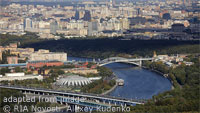Expectations High for New Moscow One Year On

(Moscow Times – themoscowtimes.com – Irina Filatova – July 16, 2013)
[The Development of New Moscow One Year On chart here: http://www.themoscowtimes.com/business/article/expectations-high-for-new-moscow-one-year-on/482838.html]
A little over a year after the territory of the city of Moscow more than doubled in size, real estate prices are stabilizing, and expectations for improving infrastructure are high.
On July 1, 2012, almost 150,000 hectares of Moscow region land in the southwest and a few enclaves and exclaves to the west and northwest became part of the city. This was the result of an ambitious initiative first voiced by then-President Dmitry Medvedev in June 2011.
Aimed at resolving some of the city’s problems, like huge traffic jams, the project sparked passionate debate, and many questions remain about its implementation. Yet City Hall is still committed to the idea, saying the expansion will bring economic benefits and attract investors.
Among the plans for the new territories is the creation of an international financial center, which the Kremlin hopes will boost foreign investment.
Other ambitions, such as the relocation of government and presidential administration offices to the suburbs, have not materialized. According to some media reports, the idea is too costly to implement, to say nothing of resistance by federal officials, who are determined to stay in the city center.
But the city authorities are ploughing ahead, promising a massive infrastructure upgrade and millions of square meters of additional housing in the new territories.
The announcement of the expansion plans caused a dramatic surge in demand for apartments in what was to become New Moscow. Residential real estate prices in the area skyrocketed by more than 20 percent in 2011.
The surge was fueled by expectations associated with the increased status of the territory, said Maria Litinetskaya, chief executive of Metrium Group, which include higher pensions, improved services and other social benefits. Prior to Medvedev’s announcement in 2011, the average price of newly built apartments in what was to become New Moscow was up to 70,000 rubles ($2,100) per square meter. This month, a square meter is selling for 85,000 rubles, she added.
Prices will continue to grow until the end of the year, Litinetskaya said, but the increase is likely to be in line with inflation, which is forecast at 5 percent to 6 percent.
“There is now nothing like the rapid price rises in New Moscow that we saw after the official announcement of the territories’ incorporation into Moscow,” said Alexander Zubets, chief executive of Novye Vatutinki, one of the biggest development projects on the new territories, which is building 1 million square meters of residential and commercial space 14 kilometers southwest of the Moscow Ring Road.
Although demand remains high, the rush is in the past, he said in e-mailed comments.
“Buyers are no longer satisfied with just a prestigious address they need extensive infrastructure, which New Moscow doesn’t have yet,” Zubets said. The new territories’ prospects depend on whether the authorities will be able to implement their announced plans to develop transportation and social infrastructure, he added.
If those plans are realized, apartment prices in some parts of New Moscow might rise on average another 15 percent to 20 percent, he added.
